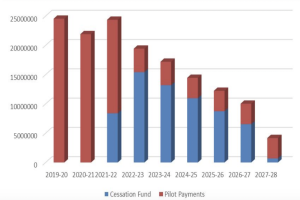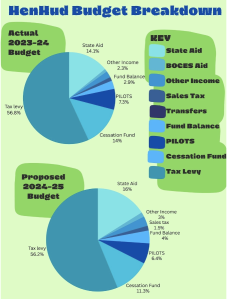The future of Hendrick Hudson school district remains uncertain as a result of the closing of Indian Point and its depletion of our revenues. The district’s budget restructuring expresses the intention of prioritizing students and staff, but taking a closer look, the truth is cloudier than that.

Initial Response
After announcing its planned closure in 2017, the largest financial supporter of the Hendrick Hudson School District, Entergy’s nuclear power plant Indian Point, permanently shut down on April 30th, 2021, almost three years ago. With it, HenHud lost a large portion of its budget.
“I was concerned,” says district parent Kevin Clarke, “I was worried that it either meant our taxes were going to go way up or the district was going to be starved for cash and start falling apart.”
Back then, all four of Clarke’s children were in HenHud schools. He says the whole reason he had moved to Westchester was to get his children into a good school district:
“I didn’t realize at the time that Hendrick Hudson was completely reliant on Indian Point.”
The shut-down of the power plant came due to a deal brokered between Former NYS governor Andrew Cuomo and Entergy, after Cuomo expressed concerns about a nuclear calamity at the power plant so close to New York City.
Enrique Catalan, the assistant superintendent for business at HenHud, stated that the board was very nervous.
“Back then [Indian Point] was 39% of our total revenues. We didn’t know what we could do to make up for those revenues.”
The district immediately sprung into action, ensuring that for the 2021-2022 academic year (the first year where the budget did not receive funds from the plant) there would be a clear plan of HenHud’s future.
Catalan says he and the Board of Education began speaking with legislators in Albany — with anyone who would hear them — to ask how HenHed was to survive. The board was afraid that taxes would have to increase by 10% per year in order to support the district, a move that would outprice many of the local community members that enjoy the area’s relatively low taxes for Westchester County.
“On the one hand, the school district could not provide the educational experience for our students that we used to, and on the other hand the community will change completely because people would have to leave.”
Catalan says that the district started cutting back on unnecessary expenses, then looked for alternative forms of revenue.
“Back then we didn’t know if there was any grounds or anything the state government would do for us to make up the revenue.”
Most importantly, Joseph Hochreiter, HenHud’s superintendent at the time, brought on consultants who recommended the implementation of the Princeton Plan. According to the consultants, once put in place it could reduce expenses up to $2 million.
Unfortunately, this plan proved ineffective in reducing expenses. The district was unable to reduce the amount of staff in the first several years of implementation as a result of continued support needed by students due to COVID-19. Now, in order to reduce teachers, the district is reorganizing again.
Current Funding
HenHud currently draws significant funding from a variety of sources. Most of which are preliminary for the 2024-2025 school year according to Catalan. However there is a general trend of decreasing support from sources like Holtec International, the company overseeing the decommissioning of Indian Point, and New York State.

Negotiations in July 2021 between Holtec International and the Hendrick Hudson School District resulted in an ag
reed $4 million dollars in Lieu of Taxes (PILOT) payments that the district received this year.
This is in place of the funds the district would have received from Indian Point during the 2023-24 school year. As of right now, the district continues to receive those payments, decreasing to $3.4 million annually for the next four years. Still, this is much lower than the PILOT payments of around $25 million per year that the district received from the power plant.
In order to further make up the difference, the district also receives other payments from the New York State government, through the Cessation Fund, which supplied the district $12.2 million for the 2023-24 school year. This number, however, will also be decreasing as time goes on.
In total, HenHud will receive $64 million from the NYS Cessation Mitigation program over 8 years. The district also receives other forms of state aid that, for the 2023-24 school year, contributed $13.3 million.
New Ways of Revenue
In order to combat the decreases in PILOT payments as time goes on, the district has increased taxation in order to further make up for the decrease in revenue. Taxes currently make up the majority of funding received in the budget.
Before the closing of Indian Point, HenHud maintained a tax levy, or collection, of 0.5%.Starting in 2019 the district has been implementing increases of 3-4% per year. Currently, the district is still below the New York State tax cap of 15.2%, the limit on the amount of taxation allowed to levy while making up for funding lost.
Yet, despite all avenues of revenue that the district has sought to counteract the budget deficit, inter-district changes have still been necessary.

For example, the Board of Education this year decided to implement a new walking policy for High school students within one mile of the school, in accordance with state policy. Catalan says that this was done in an effort to save money.
Along with this, during the 2023-24 school year, HenHud had to reduce several teaching and teaching assistants positions. Although the district tries to put students and staff first in all of its decisions regarding the budget, Catalan says that the district is still looking to reduce the number of teachers.
“What we are trying to do is adjust the expenses to the number of students.”
When he was first starting, the district had 2900 students and 235 teachers. Today, there are 2100 students and 252 teachers.
“Why do we need more teachers if we are teaching less students?” Catalan says,
Although some of the reductions were caused by teacher retirement, some were let go. When reducing teaching positions, the state regulates that districts act by seniority of staff. So despite being necessary reductions, many students were disappointed with certain losses.
“I had Ms. Mazza freshman and junior year,” says HenHud senior Christian Akhtar. Alexandra Mazza was a widely liked English teacher at HenHud last year. For students with less enthusiasm in English like Christian, Mazza was a refreshing change to the subject,
“She was always happy, energetic, and passionate about her job.”
He is disappointed that the administration had to let her go,
“She was an incredible teacher and made English fun for the class.”
In the future, HenHud hopes to continue to prioritize the student and staff experience, without having to sacrifice teaching positions, according to Principal Scollins.
“Right now, my priorities as a school leader is to make sure that my students have equal opportunity and fair opportunity and every kid can have an opportunity to learn how they need to learn or want to learn and that I don’t lose any staff.”
Catalan, however, says that it is very likely that more teachers will have to let go.
In order to do so, the district is also looking to combine more courses. In middle and high school, they are also looking to increase class sizes.
One idea Catalan also proposed was that some High school classes will run at least once during a student’s four years, but not every year. If this idea is put into place, students would be notified which years a class would run and plan their schedule accordingly.
Although cost effective, students may have a different opinion on these avenues of revenue. Sophomore Victor Delgado believes that smaller class sizes are better, since they promote peer bonding and allow for specialized teaching. In his experience, smaller classes have more inclusive and collaborative discussion.
He is also not a fan of the district’s idea on reorganization when classes are run. He believes it is an impairment on class selection, saying:
“Students will miss out on many opportunities due to limited scheduling and infrequent running times.”
Going Forward
As HenHud enacts larger changes, such as those to class sizes, Scollins wants to bring students to the front as the budget continues to be reordered and organized, allowing students to have more of a say in the district’s priorities,
“I don’t think that we have a lot of student voice here. I think some kids make it a point of having their voice heard, but I don’t think there’s a lot of opportunity of kids to have their voice heard,”
Although Scollins is aware the HenHud must cut back before the district can expand again, she wants to emphasize the importance of the students in budgeting,
“What do we really want to learn, where do our kids really want to be a part of and finding new and different ways to have those experiences that are budget neutral.”
She explained that the district is currently going through the zero-base budgeting process, which involves going line by line in the school budget to see what money is really needed where, justifying it and reorganizing accordingly — aka, starting from zero.
She is excited for the future of Hendrick Hudson’s budgeting, stating that the superintendent is very communicative and concerned over what HenHud’s students really want.
“I think that now with our new superintendent, he’s opening up that conversation and trying to get people to hear each other and listen, not just react.”
Mr. Rogulski, a longtime teacher of Hendrick Hudson High School, also expressed his confidence in the district’s foreseeable timeline.
”Those who are in charge understand that there’s an issue and being an employee here for almost 20 years now, I have known that the strong professionalism of the staff at all levels should be able to get together and solve this problem.”
He compared the situation to a “jigsaw puzzle” in which the staff must work to put all the pieces together to both upkeep student life and make up for our budget loss.
In an email, Superintendent Tromblee emphasizes the prioritization of our students and community in these matters:
“A school budget is not simply a balance sheet of revenue and expenses, it is a statement of our educational values, what we prioritize for our students. I appreciate any feedback I have received throughout the budget development process. This helps to gain a better understanding of our educational community and helps us prepare a budget during these challenging times that continues to support our students.”
After Indian Point’s closure, Scollins noticed a divide in the community, driven by uncertainty about the district’s future. She believes that if we work together, HenHud can truly make our budget work,
“If we can do that as a community and come together, that’ll make a big difference in what we do.”









